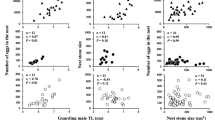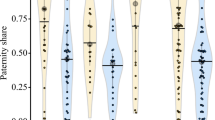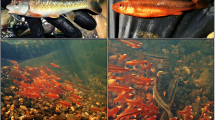Abstract
Rhinogobius sp. CB (cross band type) is an amphidromous freshwater goby which receives paternal nest care under stones on river beds. This goby is known to migrate to the upper reaches of rivers as it grows. In the present study, the relationships among male mating success of Rhinogobius sp. CB, male body size, the size frequency distribution of river bed stones and the presence of the sympatric goby Tridentiger brevispinis (which uses nest sites similar to those of Rhinogobius sp. CB) were investigated along the course of the Aizu River, Wakayama Prefecture, Japan. In the lower reach, where T. brevispinis was present and large stones were scarce, the sizes of the nest stones and the egg clusters of male Rhinogobius sp. CB were smaller than those of T. brevispinis. In the middle and the upper reaches, where T. brevispinis was absent and large stones were abundant, males of Rhinogobius sp. CB used larger nest stones than in the lower reach. In both gobies, there were positive correlations among male body size, nest size and egg cluster size in all reaches. Nest-choice experiments carried out in the laboratory, with or without a rival, showed that males of both gobies preferentially used large nest sites and that large males had an advantage in male-male competition for large nest sites. These results indicate that large male body size can increase male mating success and that male mating success increases in the upper reach in this goby. The migration pattern of Rhinogobius sp. CB was also discussed in relation to these findings.




Similar content being viewed by others
References
Andersson M (1994) Sexual selection. Princeton University Press, New Jersey
Hastings PA (1992) Nest-site size as a short-term constraint on the reproductive success of paternal fishes. Environ Biol Fish 34:213–218
Iguchi K, Mizuno N (1999) Early starvation limits survival in amphidromous fishes. J Fish Biol 54:705–712
Ito S, Yanagisawa Y (2003) Mate choice and mating pattern in a stream goby of the genus Rhinogobius. Environ Biol Fish 66:67–73
Ito S, Yanagisawa Y (2006) Determinants of male mating success in a natural population of a stream goby of the genus Rhinogobius. J Fish Biol 68:185–195
Kato M, Nishida M (1994) Biochemical and egg size evolution of freshwater fishes in the Rhinogobius brunneus complex (Pisces, Gobiidae) in Okinawa, Japan. Biol J Linn Soc 51:325–335
Kawanabe H, Mizuno N (ed) (1989) Freshwater fishes of Japan (in Japanese). Yama-kei, Tokyo
Lehtonen T, Lindström K (2004) Changes in sexual selection resulting from novel habitat use in the sand goby. OIKOS 104:327–335
Lindström K (1988) Male-male competition for nest sites in the sand goby, Pomatoschistus minutus. Oikos 53:67–73
Lugli M, Bobbio L, Torricelli P, Gandolfi G (1992) Breeding ecology and male spawning success in two hill-stream populations of the freshwater goby, Padogobius martensi. Environ Biol Fish 35:37–48
Marconato A, Bisazza A, Marin G (1989) Correlations of male reproductive success in Padogobius martensi (Gobiidae). J Fish Biol 34:889–899
Masuda Y, Ozawa T, Enami S (1989) Genetic differentiation among eight color type of the freshwater goby, Rhinogobius brunneus, from western Japan. Jpn J Ichthyol 36:30–40
McDowall RM (1992) Diadromy: origins and definitions of terminology. Copeia 1992:248–251
McDowall RM (1997) The evolution of diadromy in fishes (revisited) and its place in phylogenetic analysis. Rev Fish Biol Fish 7:443–462
Mizuno N, Uehara S, Maki M (1979) Studies on a freshwater fish, Rhinogobius brunneus (Gobiidae) IV. Habitat segregation among sympatric populations of four color type (in Japanese with English synopsis). Jpn J Ecol 29:137–147
Moriyama A, Yanagisawa Y, Mizuno N, Omori K (1998) Starvation of drifting goby due to retention of free embryos in upstream reaches. Environ Biol Fish 52:321–329
Nakabo T (ed) (2000) Fishes of Japan with key to the species second edition. Tokai University Press, Tokyo
Takahashi D, Kohda M, Yanagisawa Y (2001) Male-male competition for large nests as a determinant of male mating success in a Japanese stream goby, Rhinogobius sp. DA. Ichthyol Res 48:91–95
Tamada K (1986) Size variation of a freshwater goby, Rhinogobius brunneus, cross-band type, along the river length in terms of age and growth (in Japanese). Nanki Seibutu 28:22–34
Tamada K (2000) Distributions of the spawning grounds of four amphidromous gobies (Rhinogobius spp.) in the Aizu River, Wakayama Prefecture, Japan (in Japanese with English abstract). Jpn J Ichthyol 47:55–59
Tamada K (2001) Clutch size and egg size in three species of Rhinogobius complex dwelling in a single stream (in Japanese with English abstract). Jpn J Ichthyol 48:49–52
Tamada K, Iwata K (2005) Intra-specific variations of egg size, clutch size and larval survival related to maternal size in amphidromous Rhinogobius goby. Environ Biol Fish 73:379–389
Taru M, Kanda T, Sunobe T (2005) Competition for spawning sites between two gobiid fishes, Bathygobius fuscus and Eviota abax, derived by alternation of mating tactics of the former. Ichthyol Res 52:198–201
Tsukamoto K (1991) Age and growth of ayu larvae Plecogrossus altivelis collected in the Nagara, Kiso and Tone River during the downstream migration. Nippon Suisan Gakkaishi 57:2013–2022
Acknowledgements
I thank Dr. Katsuya Iwata and Dr. Tsunenori Koga (Wakayama University) and Dr. Daisuke Takahashi (Kyoto University) for their helpful advice. The study was supported in part by a Grant-in-Aid for science research from the Japan Society for the Promotion of Science (No.17916018).
Author information
Authors and Affiliations
Corresponding author
About this article
Cite this article
Tamada, K. Variation in male mating success in the paternal nest brooder, Rhinogobius goby, along a river course. Ecol Res 23, 91–97 (2008). https://doi.org/10.1007/s11284-007-0333-8
Received:
Accepted:
Published:
Issue Date:
DOI: https://doi.org/10.1007/s11284-007-0333-8




